Showing Spotlights 1953 - 1960 of 2784 in category All (newest first):
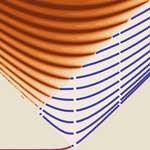 Graphene is an impressive condensed matter system that, to all appearances, never ceases to impress and challenge our entrenched intuitions regarding solid state systems. But graphene is a highly atypical electronic system in that it consists of nothing but a surface. Researchers at Boston University have found that local deformations in a graphene sheet can strongly influence electron flow across the system, causing suppression of conductance at low densities, and making electrons behave as if they were living in a nanoribbon or quantum dot. All this without cutting the graphene sheet, which opens the prospect towards a reversible and controllable transport gap in monolayer graphene via strain engineering.
Graphene is an impressive condensed matter system that, to all appearances, never ceases to impress and challenge our entrenched intuitions regarding solid state systems. But graphene is a highly atypical electronic system in that it consists of nothing but a surface. Researchers at Boston University have found that local deformations in a graphene sheet can strongly influence electron flow across the system, causing suppression of conductance at low densities, and making electrons behave as if they were living in a nanoribbon or quantum dot. All this without cutting the graphene sheet, which opens the prospect towards a reversible and controllable transport gap in monolayer graphene via strain engineering.
Oct 6th, 2009
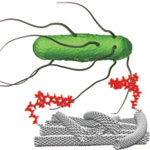 In their effort to develop a fast, sensitive, selective, inexpensive, and easy-to-use method for detecting and quantifying pathogenic bacterial cells, researchers in Spain have now demonstrated a carbon nanotube based potentiometric biosensor for selectively detecting one single colony-forming unit of the bacterium Salmonella Typhi in close to real time. The most important strength of this biosensor is that simple positive/negative tests can be carried out in real zero-tolerance conditions and without cross reaction with other types of bacteria. The ease with which measurements are taken in potentiometric analysis opens the door to greater simplicity in microbiological analysis.
In their effort to develop a fast, sensitive, selective, inexpensive, and easy-to-use method for detecting and quantifying pathogenic bacterial cells, researchers in Spain have now demonstrated a carbon nanotube based potentiometric biosensor for selectively detecting one single colony-forming unit of the bacterium Salmonella Typhi in close to real time. The most important strength of this biosensor is that simple positive/negative tests can be carried out in real zero-tolerance conditions and without cross reaction with other types of bacteria. The ease with which measurements are taken in potentiometric analysis opens the door to greater simplicity in microbiological analysis.
Oct 5th, 2009
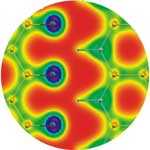 Nanostructures present novel material properties and interesting insight into new physical phenomena. However, from a technical and commercial application point of view, a successful bridging between the nanoscale specific significance with large-scale applications must be made to obtain these benefits. One of the 'hottest' nanomaterials at the moment is graphene, a one-atom thick sheet of carbon. Ribbons made from graphene, basically stripes that look like molecular chicken wire, show even more unconventional properties than graphene, especially when they are less than 100 nm wide. Any material approach to use graphene nanoribbons for larger-scale applications must be able to assemble them into macroscopic materials, while preserving their physical significance and novel properties at these larger scales. Researchers at MIT have addressed this issue by proposing hierarchical assemblies of graphene nanoribbons through hydrogen bonds, inspired by biological structures found in nature such as proteins and DNA macromolecules.
Nanostructures present novel material properties and interesting insight into new physical phenomena. However, from a technical and commercial application point of view, a successful bridging between the nanoscale specific significance with large-scale applications must be made to obtain these benefits. One of the 'hottest' nanomaterials at the moment is graphene, a one-atom thick sheet of carbon. Ribbons made from graphene, basically stripes that look like molecular chicken wire, show even more unconventional properties than graphene, especially when they are less than 100 nm wide. Any material approach to use graphene nanoribbons for larger-scale applications must be able to assemble them into macroscopic materials, while preserving their physical significance and novel properties at these larger scales. Researchers at MIT have addressed this issue by proposing hierarchical assemblies of graphene nanoribbons through hydrogen bonds, inspired by biological structures found in nature such as proteins and DNA macromolecules.
Oct 2nd, 2009
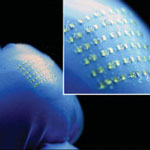 Imagine this: Chip-based credit cards and other smart cards on paper; intelligent sensors and electronics on doctors' surgical gloves; health monitors printed on T-shirts; diagnostic devices embedded in your baby's diapers; human machine interfaces on workers' leather gloves. These are just some of the systems that researchers envision today and that will become reality tomorrow thanks to research teams like John Rogers' group at the University of Illinois. Nanotechnology-enabled electronics of the future will be invisible, i.e. transparent, or flexible, or both. One of the areas Rogers' group focus on is creating materials and processes that will allow high-performance electronics that are flexible and stretchable. The group has now demonstrated examples of CMOS circuits on paper, fabric, leather and vinyl.
Imagine this: Chip-based credit cards and other smart cards on paper; intelligent sensors and electronics on doctors' surgical gloves; health monitors printed on T-shirts; diagnostic devices embedded in your baby's diapers; human machine interfaces on workers' leather gloves. These are just some of the systems that researchers envision today and that will become reality tomorrow thanks to research teams like John Rogers' group at the University of Illinois. Nanotechnology-enabled electronics of the future will be invisible, i.e. transparent, or flexible, or both. One of the areas Rogers' group focus on is creating materials and processes that will allow high-performance electronics that are flexible and stretchable. The group has now demonstrated examples of CMOS circuits on paper, fabric, leather and vinyl.
Oct 1st, 2009
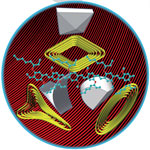 To date, a number of nanotechnology fabrication studies have focused on creating hierarchically ordered nanostructures using lithographic techniques. However, lithographic methods involve high processing and maintenance costs, and require an iterative, multi-step procedure that makes the structure formation process more complex and less reliable. By contrast, a novel nanofabrication method is fast and cost-effective, dispensing with the need for multistage lithography and externally applied fields. This new technique needs only a drop of diblock polymer solution, a curved upper surface and a flat silicon substrate, and a selective solvent. This is the first study of creating hierarchically ordered nanostructures composed of block copolymers with unprecedented regularity by controlled evaporative self-assembly.
To date, a number of nanotechnology fabrication studies have focused on creating hierarchically ordered nanostructures using lithographic techniques. However, lithographic methods involve high processing and maintenance costs, and require an iterative, multi-step procedure that makes the structure formation process more complex and less reliable. By contrast, a novel nanofabrication method is fast and cost-effective, dispensing with the need for multistage lithography and externally applied fields. This new technique needs only a drop of diblock polymer solution, a curved upper surface and a flat silicon substrate, and a selective solvent. This is the first study of creating hierarchically ordered nanostructures composed of block copolymers with unprecedented regularity by controlled evaporative self-assembly.
Sep 30th, 2009
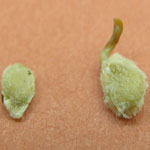 To what degree nanoparticles are uptaken by plants and what their effect is on plant development is an important issue in determining the environmental impact of nanomaterials. Previously we have covered several research projects that have begun to explore nanotechnology's impact on major food crops and some of them have demonstrated quite a negative impact. But some research results also show a possible positive effect, like a recent study that demonstrates that carbon nanotubes (CNTs) can dramatically accelerate the germination and growth of tomato seeds. Work like this contributes to an important body of interdisciplinary research where nanotechnology, plant biology and biotechnology converge to open new perspectives for solving some of the important challenges of our times such as increased food and biofuel production.
To what degree nanoparticles are uptaken by plants and what their effect is on plant development is an important issue in determining the environmental impact of nanomaterials. Previously we have covered several research projects that have begun to explore nanotechnology's impact on major food crops and some of them have demonstrated quite a negative impact. But some research results also show a possible positive effect, like a recent study that demonstrates that carbon nanotubes (CNTs) can dramatically accelerate the germination and growth of tomato seeds. Work like this contributes to an important body of interdisciplinary research where nanotechnology, plant biology and biotechnology converge to open new perspectives for solving some of the important challenges of our times such as increased food and biofuel production.
Sep 29th, 2009
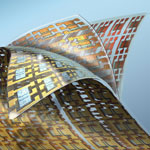 Here is the book you all have been waiting for: Nano-Society - Pushing the boundaries of technology. Written by Nanowerk's Michael Berger, this book puts a spotlight on some of the scientists who are pushing the boundaries of technology and it gives examples of their work and how they are advancing knowledge one little step at a time. Nano-Society is the latest addition to RSC Publishing's Nanoscience and Nanotechnology series. Edited by Sir Harry Kroto, Paul O'Brien, and Harold Craighead, the series provides a comprehensive source of information on research associated with nanostructured materials and miniaturized lab-on-a-chip technologies. The book covers 122 very specific research projects that are happening in laboratories around the world and provides commentaries from the scientists in their own words.
Here is the book you all have been waiting for: Nano-Society - Pushing the boundaries of technology. Written by Nanowerk's Michael Berger, this book puts a spotlight on some of the scientists who are pushing the boundaries of technology and it gives examples of their work and how they are advancing knowledge one little step at a time. Nano-Society is the latest addition to RSC Publishing's Nanoscience and Nanotechnology series. Edited by Sir Harry Kroto, Paul O'Brien, and Harold Craighead, the series provides a comprehensive source of information on research associated with nanostructured materials and miniaturized lab-on-a-chip technologies. The book covers 122 very specific research projects that are happening in laboratories around the world and provides commentaries from the scientists in their own words.
Sep 28th, 2009
 Sand. Shrubs. Burst tires. More sand. The last thing you would expect as you drive along the Red Sea near Mecca is to encounter an ultramodern science city. Yet there it is. Appearing after an 80 kilometer drive from Jeddah, Saudi Arabia's second-largest city, the 36 square kilometer campus of King Abdullah University for Science and Technology (KAUST) appears like a Fata Morgana out of the desert sand. Yesterday, September 23rd, King Abdullah of Saudi Arabia officially opened the country's most modern and ambitious university near the old fishing village of Thuwal. Nanowerk was invited to attend the spectacular opening ceremony. Much more than a future elite university, the vision behind KAUST is to create the nucleus of a modern society, free from the strict religious dictates of a conservative Islamic culture, and laying the foundation for a science and technology based society of future generations.
Sand. Shrubs. Burst tires. More sand. The last thing you would expect as you drive along the Red Sea near Mecca is to encounter an ultramodern science city. Yet there it is. Appearing after an 80 kilometer drive from Jeddah, Saudi Arabia's second-largest city, the 36 square kilometer campus of King Abdullah University for Science and Technology (KAUST) appears like a Fata Morgana out of the desert sand. Yesterday, September 23rd, King Abdullah of Saudi Arabia officially opened the country's most modern and ambitious university near the old fishing village of Thuwal. Nanowerk was invited to attend the spectacular opening ceremony. Much more than a future elite university, the vision behind KAUST is to create the nucleus of a modern society, free from the strict religious dictates of a conservative Islamic culture, and laying the foundation for a science and technology based society of future generations.
Sep 24th, 2009
 Graphene is an impressive condensed matter system that, to all appearances, never ceases to impress and challenge our entrenched intuitions regarding solid state systems. But graphene is a highly atypical electronic system in that it consists of nothing but a surface. Researchers at Boston University have found that local deformations in a graphene sheet can strongly influence electron flow across the system, causing suppression of conductance at low densities, and making electrons behave as if they were living in a nanoribbon or quantum dot. All this without cutting the graphene sheet, which opens the prospect towards a reversible and controllable transport gap in monolayer graphene via strain engineering.
Graphene is an impressive condensed matter system that, to all appearances, never ceases to impress and challenge our entrenched intuitions regarding solid state systems. But graphene is a highly atypical electronic system in that it consists of nothing but a surface. Researchers at Boston University have found that local deformations in a graphene sheet can strongly influence electron flow across the system, causing suppression of conductance at low densities, and making electrons behave as if they were living in a nanoribbon or quantum dot. All this without cutting the graphene sheet, which opens the prospect towards a reversible and controllable transport gap in monolayer graphene via strain engineering. 
 Subscribe to our Nanotechnology Spotlight feed
Subscribe to our Nanotechnology Spotlight feed





